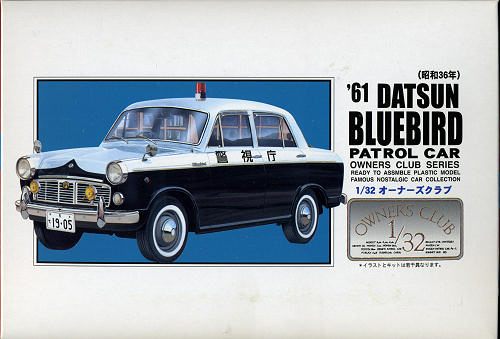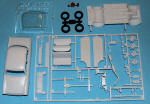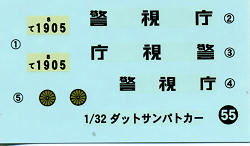
Arii 1/32 1961 Datsun Bluebird Patrol Car
| KIT #: | 31067 |
| PRICE: | 480 yen (around $6.00) from Hobby Link Japan |
| DECALS: | One option |
| REVIEWER: | Scott Van Aken |
| NOTES: | An ex-LS kit |

| HISTORY |
The Nissan Bluebird is a compact- to medium-sized car launched in 1957. The nameplate still exists today on the Nissan Pulsar-based Nissan Bluebird Sylphy in Japan, and on the U13-based Nissan Bluebird in mainland China.
The Bluebird's traditional competitor was the Toyota Corona from almost the very beginning of the product line. The Bluebird was originally developed to compete with the Corona, as the Corona was developed to continue offering a sedan used as a taxi as the Toyota Crown began to grow in size. Every generation of the Bluebird has been available as a taxi, duties that are shared with base level Nissan Cedrics.
It is one of the longest-running nameplates from a Japanese automaker. It even spawned the S130 Fairlady Z/280ZX, which in turn spawned the Maxima (originally 910 Bluebird/S130 Fairlady Z based), the 160J/710/Violet/Auster/Stanza line, and the US-built Altima line.
The second generation Datsun Bluebird which debuted for August 1959 was an all-new car, and was available in Japan at the dealership sales channel Nissan Exhibition. The 310 series had a 1 L engine from the 210 model. The 310 was built from 1960-1963. There were three models built: 310 (1960), 311 (1961), and 312 (1962–1963). In Taiwan it also replaced the 701 and was known as Yue Loong Bluebird 704. The Datsun 312 was also sold in Korea.The 310 series was also built in South Africa at a factory in Rosslyn Pretoria in CKD form during 1962 and 1963.
In July 1960, a five-door station wagon was added (WP310). The P310 was powered by the 1.2L Nissan E engine. A smaller engine version (simply called "310") was powered by the 1.0L Nissan C engine. The P311 and P312 (powered by the 60 hp 1.2L Nissan E-1 engine) also had smaller engined versions ("311" and "312") that were powered by the 45 hp 1.0L Nissan C-1 engine. The 310 and 311 were equipped with a 3-speed manual transmission (fully synchronized for the 311 and 312). The station wagon was also available for the 311 and 312. The 312 was also available in a deluxe version (DP312). A trim model called the "Fancy Deluxe" (model code DP312-L) was marketed for the female driver; it featured a pale yellow exterior, pale yellow/grey interior, high heel shoe holder under the dash, a vanity mirror on the back of the driver's side sun visor, a turn signal relay that played music, curtains, automatic clutch, and bigger mirrors. By February 1961, a 1.2 L overhead-valve engine (codenamed E-1) became an option on a higher-trim DX model.
Styling tended to ape larger American cars. A very small number did make it to the United States, but were flops.
| THE KIT |
 As
with just about all these Arii/LS 1/32 kits, we are not talking about a ton of
detail. These are all curbsides and this one is no exception. What this kit does
have that the others I have build do not, is a suspension. In addition to a
front and rear suspension section, a full exhaust with multiple
mufflers/resonators is included.
As
with just about all these Arii/LS 1/32 kits, we are not talking about a ton of
detail. These are all curbsides and this one is no exception. What this kit does
have that the others I have build do not, is a suspension. In addition to a
front and rear suspension section, a full exhaust with multiple
mufflers/resonators is included.
For the interior, there are front and rear bench seats along with interior door panels. The instrument panel/dash takes decals for the instruments and includes a steering wheel with column shifter. The full, one-piece window insert has a spot for a rear view mirror. Tires are rubber and fit over one piece wheels. There is a small hub cap. For the outside, you have a grille/headlight piece, fore and aft bumpers with clear headlight covers and driving light covers. The driving lights (and they may be flashing red lights as this is a police car) are molded onto the front bumper. There are clear tail lights. Only the 'bubble' on the roof is in red plastic.
 The kit will
require you to paint all the bits that are chrome and suggest a standard silver
paint. However, many of us will use Alclad II Chrome to do these parts and will
probably use Bare Metal Foil Chrome foil for the window trim. The tail lights
will also need to be painted with clear red. The instructions have seven build
steps that include Gunze paint references. This and the parts layout consist of
about 7/8ths of a side of the instruction sheet with the other side being
adverts for other cars in the line. Typical of Japanese police cars, this one is
white over black. The decal sheet is well printed and while it may be a tad
thick for some, it has proven in the past to stick very well.
The kit will
require you to paint all the bits that are chrome and suggest a standard silver
paint. However, many of us will use Alclad II Chrome to do these parts and will
probably use Bare Metal Foil Chrome foil for the window trim. The tail lights
will also need to be painted with clear red. The instructions have seven build
steps that include Gunze paint references. This and the parts layout consist of
about 7/8ths of a side of the instruction sheet with the other side being
adverts for other cars in the line. Typical of Japanese police cars, this one is
white over black. The decal sheet is well printed and while it may be a tad
thick for some, it has proven in the past to stick very well.
| CONCLUSIONS |
If you like modeling in 1/32 scale or just want something that will not require advanced modeling skills that are sometimes required, then this is a kit for you. Not only that, but it will not break the bank, even if ordering it from overseas.
| REFERENCES |
http://en.wikipedia.org/wiki/Nissan_Bluebird
January 2011 Thanks to
www.hlj.com for
the preview kit. Get yours
here. If you would like your product reviewed fairly and fairly quickly, please contact the editor or see other details in the Note to
Contributors.